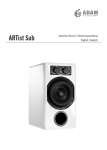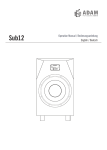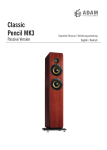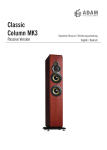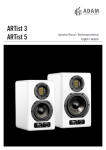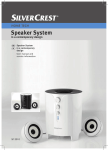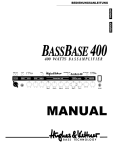Download User Manual (pdf 1002 KB)
Transcript
MP1 Operation Manual English Safety Instructions Please read the following safety instructions before setting up your system. Keep the instructions for further reference. Please take notice of the warnings and follow the instructions. Caution Risk of electrical shock Do not open Risque de shock electrique Ne pas ouvrier CAUTION: TO REDUCE THE RISK OF FIRE OR ELECTRIC SHOCK, DO NOT REMOVE BACK COVER OR ANY OTHER PART. NO USER-SERVICABLE PARTS INSIDE. DO NOT EXPOSE THIS EQUIPMENT TO RAIN OR MOISTURE. REFER SERVICING TO QUALIFIED PERSONNEL. Caution: To reduce the risk of electric shock, do not open the loudspeaker. There are no user-serviceable parts inside. Refer servicing to qualified service personnel. This product, as well as all attached extension cords, must be terminated with an earth ground three-conductor AC mains power cord like the one supplied with the product. To prevent shock hazard, all three components must always be used. Check if the specified voltage matches the voltage of the power supply you use. If this is not the case do not connect the loudspeakers to a power source! Please contact your local dealer or national distributor. Do not place this unit on an unstable cart, stand or tripod, bracket or table. The unit may fall, causing serious injury and/or serious damage. When a cart is used, use caution when moving the cart/apparatus combination. Do not expose this product to rain or moisture, never wet the inside with any liquid and never pour or spill liquids directly onto this unit. Please do not put any objects filled with liquids (e.g. vases, etc.) onto the speaker. Never replace any fuse with a value or type other than those specified. Never bypass any fuse. Always switch off your entire system before connecting or disconnecting any cables, or when cleaning any components. 2 Safety Instructions Protect the cord from being walked on or pinched. To completely disconnect from AC mains, disconnect the power supply from the AC receptacle. Always use fully checked cables. Defective cables can harm your speakers. They are a common source for any kind of noise, hum, crackling etc. The monitor should be installed near the socket outlet and disconnection of the device should be easily accessible. Assure free airflow behind the speakers to maintain sufficient cooling. Never use flammable or combustible chemicals for cleaning audio components. Never expose this product to extremely high or low temperatures. Never operate this product in an explosive atmosphere. Avoid touching the speaker membranes and do not block the woofer’s ventilation ports. Please note that the drivers build up a magnetic field. Do not ply with magnetic items at close range to the diaphragms. High SPLs may damage your hearing! Please do not get close to loudspeakers when used at high volumes. Always unplug sensitive electronic equipment during lightning storms. Always keep electrical equipment out of the reach of children. MP1 Manual / English 3 Table of contents Safety Instructions..............................................2-3 1. Introduction........................................................5 2. 2.1 2.2 Quick Start.........................................................6 Important Information........................................6 Connecting the speakers....................................6 3. 3.1 3.2 3.3 3.4 Speaker Placement.............................................7-8 Room acoustics..................................................7 General recommendations.................................7 The Stereo Triangle.............................................8 Surround placement...........................................8 4. 4.1 4.2 4.3 4.4 4.5 4.6 4.7 Speaker Adjustment...........................................9-10 The Front Control Panel......................................9 Input Gain...........................................................9 High Gain............................................................9 Mid Gain.............................................................9 Bass Gain............................................................10 High / Low Shelving EQs....................................10 LEDs...................................................................10 5. 5.1 5.2 Troubleshooting..................................................11 No or distorted signal.........................................11 Parasitic noises..................................................11 6. Maintenance.......................................................12 7. Shipping / Packaging.........................................12 8. Environmental Information.................................12 9. EU Declaration of Conformity.............................13 10. Limited Warranty................................................14 10.1 Terms and Conditions.........................................14 10.2 How to claim.......................................................14 11. 4 Technical Data....................................................15 1. Introduction Dear customer, Thank you for choosing the ADAM Audio MP1. The ADAM MP1 “Mastering Piece” provides the ultimate monitoring tool for the final stage of the recording process. Since this is the last chance to sculpt, change and fine tune a recording before it becomes available to the public, it is crucial for a mastering engineer to know for sure that the monitors provide him with the most honest and revealing sonic “picture” possible. It was to answer this need that the MP1 was created. The MP1 is a four-way ported active system that uses our proprietary ART tweeter and midrange driver, two 7“ Ceramic cone midrange drivers and one side-firing 12“ HexaCone© woofer which is driven by a no-compromise 500W PWM amplifier. A very stable bass reflex cabinet, enabling the woofer‘s frequency response reaching down to 23 Hz, is also responsible for an extremely pure sound that is free from overemphasizing artifacts, resulting in exceedingly tight and solid bass response. This manual is intended to provide you with information about your new ADAMs. It contains important information regarding safety, setting up, handling, and warranty. We request that you read these sections carefully to ensure easy set up and prevent potential problems. If you have any questions about this or any of our products, please don’t hesitate to contact us – we will be happy to assist you. For detailed information concerning ADAM’s technologies and products, complete reviews, and a list of worldwide ADAM users and studios, please visit our website: www.adam-audio.com You are invited to share your experience with our products by joining us on Facebook and also, if you don’t want to miss out on the latest info on ADAM Professional Audio, come and follow us on Twitter! We hope very much that you really enjoy your new loudspeakers, and wish you many delightful hours with them. The ADAM Audio Team MP1 Manual / English 5 2. Quick Start 2.1 Important Information for set up After having unpacked your loudspeakers, please allow the system to acclimate to the temperature of the room for approximately an hour. We recommend using high quality cables to guarantee optimal performance. It is important to ensure the speakers stand firmly on a solid surface! We recommend retaining the original packaging, as it is the best way to guarantee safe transportation should the need to do so arise. Please note that the loudspeakers will take some break-in time to achieve optimum sonic performance. 2.2 Connecting the speakers a) Before connecting the loudspeakers to your audio components and the power source make sure that both the loudspeakers and your audio source are switched off and set the level controls fully counterclockwise. b) Connect the loudspeakers with your audio source by using XLR cables. The male plug goes into the loudspeaker, the female plug into your audio component. c) Check if the specified voltage matches the voltage of the power supply you use. If this is not the case do not connect the loudspeakers to a power source! Please contact your local dealer or national distributor. If the voltages match, use the included power cables to connect the loudspeaker to the AC sockets. d) Switch on the main on/off switches on the back panel of the loudspeakers. e) Make sure that the line out level (volume) of your stereo is either at a low level or all the way off. Then, switch on your audio system. f) Switch on the Standby switch on the front panel of your MP1. g) Turn on your source of music and adjust the volume carefully. 6 3. Speaker Placement The proper positioning of your loudspeakers is of extreme importance to the sound quality. We would therefore like to give you some advice concerning room acoustics and the setting up of your loudspeakers. Since every room is unique, we can only offer general recommendations. 3.1 Room acoustics Room acoustics come down to essentially three aspects: a) Reverberation: The ‘sound’ of a room is to some extend a result of its reverberation, i.e. to how the sound waves are reflected. Soft furniture (like carpets, curtains, or sofas) tends to absorb sound waves, especially higher frequencies. Hard materials like stone or glass reflect sound waves almost entirely. In general, reverberant rooms are rather unforgiving in terms of authentic music reproduction due to the great number of reflections. b) The room dimensions: The volume of a room is the second important aspect of its acoustics. The same loudspeaker will sound different in different sized rooms with similar sonic characteristics. Therefore, the size of your room partly determines the positioning of your loudspeakers. c) The listening distance: The distance between the listener and the sound source is the third crucial aspect in loudspeaker positioning. If this distance is either too great or too small, the sound will be compromised. 3.2 General recommendations • Please make sure that there are no obstacles in the way from the monitor to your ears. You should be able to see the speakers completely. • The distance to the surrounding walls should be at least 70 cm to avoid early reflections, which will degrade the sound. • The loudspeakers should be aligned with the listener’s position. • The Tweeter should be positioned approximately at the height of your ears. If the speaker does not point right in your direction, you might lose sound information. • Please note that vibrating parts of nearby objects can mask the sound. MP1 Manual / English 7 3. Speaker Placement 3.3 The Stereo Triangle If the loudspeaker is going to be used for stereo applications, the optimum listening position should be at the top of an imaginary equilateral triangle with the two loudspeakers placed at the other two points of this triangle. The loudspeakers should be aligned with the listener’s position. 3.4 Surround Placement 8 Speaker positioning for multi-channel stereo purposes is ideally based on a circle with speakers placed at 0° (Center), 30° (Front Right), 110° (Rear Right), 250° (Rear Left), 330° (Front Left), with the listener being the circle’s center (Radius between 0.7-2.0 m). This ITU recommended configuration may vary depending on the purpose of the control room (music or film). However, it is recommended to create a symmetrical listening position with the front side and surround speaker pointing to the listener’s ear. 4. Speaker Adjustment 4.1 The front control panel On the front you will find a highly sophisticated control panel that allows detailed fine-tuning of your loudspeakers to your particular room acoustics and personal listening preferences. The following tips are intended to assist you at using the controls in the best manner. On Input Gain OL Standby EQ >6 kHz High Gain -10 dB +10 dB -4 dB -6 dB +6 dB Bass Gain -2 dB +2 dB Mid Gain MP1 +4 dB -6 dB +6 dB -6 dB +6 dB EQ <150 Hz Please note that using the controls may have a great impact on the overall sound characteristics of your loudspeakers. We recommend using the controls with utmost care and only after several audio tests with familiar recordings. 4.2 Input Gain On ‘Input Gain’ regulates the overall input sensitivity of your loudspeaker within a range of -10 to +10 dB, and controls the volume of your loudspeaker equally in all frequency ranges. 4.3 High Gain Input Gain OL On Input Gain Whereas the ‘Input Gain’ raises or lowers the overall input Standby On sensitivity up to +/-10 dB, the ‘High Gain’ works only within theInput Gain dB +10 dB frequency range of the tweeter, raising or lowering up to +/-4 -10 dB. MP1 MP1 -10 dB +10 dB 4.4 Mid Gain OL OL -6 dB +6 dB The ‘Mid Gain’ raises or lowers the gain of the midrange driver up Bass Gain Standby -6 dB +6 dB to +/-2 dB. Bass Gain Standby High Gain -10 dB +10 dB -4 dB -6 dB +6 dB High Gain Bass Gain -2 dB +2 dB kHz EQ Mid>6Gain MP1 High Gain +4 dB -4 dB -4 dB +4 dB -2 dB +2 dB Mid Gain -2 dB +2 dB Mid Gain MP1 Manual / English +4 dB EQ >6 kHz -6 dB +6 dB -6 dB +6 dB -6 dB +6 dB EQ <150 Hz -6 dB +6 dB EQ <150 Hz 9 4. Speaker Adjustment On Input Gain 4.5 Bass Gain OL The ‘Bass Gain’ raises or lowers the gain of the woofer up to +/-6 dB. Standby 4.6 High / Low Shelving EQs On Input Gain Standby Room EQ >6 kHz for high frequencies above 6 kHz Bass Gain -4 dB +4 dB -6 dB -6 dB +6 dB Bass Gain -2 dB +2 dB Mid Gain -6 dB EQ MP1 EQ >6 kHz Gain High Gain Whereas the gains raise or lower the volume of aInput single -10 dB +10 dB -4 dB +4 dB driver as a whole, the two room equalizers work differently. -10 dB +10 dB -4 dB +4 dB The ‘EQ >6kHz’ is a shelving filter that progressively raises OL or lowers the range above 6 kHz up to 6 dB. The ‘EQ <150Hz’ does the same for the frequency band OL below -6 dB +6150 dB -2 dB +2 dB Bass Gain Mid Gain Hz (please see figures below). Standby -6 dB +6 dB -2 dB +2 dB MP1 MP1 Mid Gain EQ -10 dB +10 dB High Gain On High Gain EQ >6 kHz -6 dB +6 dB -6 dB +6 dB -6 dB +6 dB EQ <150 Hz -6 dB +6 dB EQ <150 Hz Room EQ <150 Hz for low frequencies below 150 Hz 4.7 LEDs 10 There are two diodes on the front panel. When the loudspeaker is being switched on, the Overload-LED will flash red a few times. This does not indicate an overload! It signalizes the control function of the protective circuit. Afterwards, the On-LED will start to glow green, indicating power on. Only if the Overload-LED flashes red during operation, it does indicate an overload. Then, the protective circuit will be activated to prevent the speaker from damage. On OL Standby Input Gain Hi -10 dB +10 dB -4 dB -6 dB +6 dB Bass Gain -2 d M MP1 5. Troubleshooting All ADAM products are designed and manufactured to the highest quality standards. However, if any problems with your speaker occur, we recommend proceeding as follows: 5.1 Problem: The LED shows normal operation (green) but there is either no or only a distorted audio signal. If both (all) speakers are affected, the reason can probably be found within the signal path. If only one speaker is affected, the problem will probably be within this speaker. a) Check the wiring. Is the cable defective? Are all cables connected correctly? b) Check the signal path. Interchange the cables of both loudspeakers. Does the problem change with one of the cables? Connect the monitor as directly to the signal source as possible (please mind the volume!). Is another part of the signal path (e.g. mixer, subwoofer) defective? If the answer to all these questions is ‘no’, the problem is being caused by the loudspeaker with the utmost probability. If the answer to at least one of these questions is ‘yes’, there will probably be another defective device within the signal path. 5.2 Problem: You hear parasitic noises (like humming, buzzing, soughing, cracking). Please disconnect the signal cables. If the noises disappear, check the signal path. If the noises can still be heard, check for other electrical devices close to the speakers (mobile phones, switching power supplies, etc.). If there is no interfering device the speaker will probably cause the problem. MP1 Manual / English 11 6. Maintenance Please switch the loudspeaker off before cleaning! Please note that the diaphragms build up a magnetic field. Do not ply with magnetic items at close range to the diaphragms. Please make sure that no liquids get inside the cabinet. Do not spray any fluids on the speaker. Do not use a wet cloth for cleaning. Do not use flammable or acidic chemicals for cleaning. Do not touch the membranes of the loudspeakers. We recommend using a lint-free, damp cloth for cleaning. The loudspeaker membranes may be dusted using a very soft brush. 7. Shipping / Packaging In case you have to send your speakers to any other location, it is of vital importance that you use the original packaging materials. Experience has shown that it is very difficult to avoid damage if you have to send them without these. ADAM Audio can not be held responsible for damages due to improper packaging. If a transport is necessary and the original shipping carton is not available, a new one can be purchased from ADAM Audio. 8. Environmental Information All ADAM products comply with international directives on the Restriction of Hazardous Substances (RoHS) in electrical / electronical equipment and the disposal of Waste Electrical / Electronic Equipment (WEEE). For disposal, please consult your local authorities for further information. 12 9. EU Declaration of Conformity We, ADAM Audio GmbH whose registered office is situated at Ederstr. 16, 12059 Berlin, Germany declare under our sole responsibility that the product: MP1 complies with the EU Electro-Magnetic Compatibility (EMC) Directive 89/336/EEC, in pursuance of which the following standards have been applied: EN 61000-6-1 : 2001 EN 61000-6-3 : 2001 EN 55020 : 2002 EN 55013 : 2001 and complies with the EU General Product Safety 2001/95/EC, in pursuance of which the following standard has been applied: EN 60065 : 2002. This declaration attests that the manufacturing process quality control and product documentation accord with the need to assure continued compliance. The attention of the user is drawn to any special measures regarding the use of this equipment that may be detailed in the owner’s manual. Signed: Klaus Heinz Director ADAM Audio MP1 Manual / English 13 10. Warranty ADAM Audio GmbH provides a five year limited warranty for this product. 10.1Terms and Conditions This warranty is limited to the repair of the equipment or, if necessary, the replacement of parts or the product and return shipping within the country of purchase. This warranty complements any national/regional law obligations of dealers or national distributors and does not affect your statutory rights as a customer. Neither other transportation, nor any other costs, nor any risk for removal, transportation and installation of products is covered by this warranty. Products whose serial number have been altered, deleted, removed or made illegible are excluded from this warranty. The warranty will not be applicable in cases other than defects in materials and/or workmanship at the time of purchase and will not be applicable: a) for damages caused by incorrect installation, connection or packing, b) for damages caused by any use other than correct use described in the user manual, c) for damages caused by faulty or unsuitable ancillary equipment, d) if repairs or modifications have been executed by an unauthorized person, e) for damages caused by accidents, lightning, water, fire heat, public disturbances or any other cause beyond the reasonable control of ADAM Audio. 10.2How to claim repairs under warranty Should service be required, please contact the ADAM Audio dealer where the product has been purchased. If the equipment is being used outside the country of purchase, the international shipping costs have to be paid for by the owner of the product. Service may be supplied by your ADAM Audio national distributor in the country of residence. In this case, the service costs have to be paid for by the owner of the product whereas the costs for parts to be repaired or replaced are free of charge. Please visit our website to get the contact details of your local distributor. To validate your warranty, you will need a copy of your original sales invoice with the date of purchase. 14 11. Technical Data Tweeter Velocity transfer ratio Equivalent diaphragm ø ART 4:1 2.5“ / 60 mm Midrange ART Velocity transfer ratio 3.5:1 Equivalent diaphragm ø Midwoofer (2x) Cone material Subwoofer Cone material Built-in amplifiers 5.5“ / 145 mm 7“ / 180 mm Ceramic 12.5“ / 315 mm HexaCone 4 Subwoofer channel 1/2 500 W / 700 W Midwoofer channel 1/2 250 W / 350 W Midrange channel 1/2 250 W / 350 W Tweeter channel 1/2 250 W / 350 W Control Panel yes Input Gain ±10 dB High Gain ±4 dB Mid Gain ±2 dB Bass Gain ± 6 dB High Shelf EQ > 6 kHz ± 6 dB Low Shelf EQ < 150 Hz ± 6 dB General Data Frequency response THD > 80 Hz ≤ 0.5 % Long term output ≥ 116 dB Max. peak acoustic output in 1m per pair Crossover frequencies 1 = long term IEC 265-8-Wrms / 10 min 2 = nominal IEC 265-8 = Peak Power 5 µsec 23 Hz - 35 kHz Analog Input Input Impedance Weight Height x Width x Depth Warranty Operating temperature Storage temperature Humidity ≥ 126 dB 80 / 800 / 3.100 Hz XLR 10 kΩ 60 kg / 132.3 lb. 1600 x 250 x 450 mm / 63“ x 10“ x 17.5“ 5 years 0° C to 40° C (32° F to 104° F) -30° C to 70° C (-22° F to 167° F) Max. 90 % not condensing MP1 Manual / English 15 ADAM Audio GmbH Ederstr. 16 12059 Berlin GERMANY tel: +49 30-863 00 97-0 fax: +49 30-863 00 97-7 email: [email protected] ADAM Audio UK Ltd. email: [email protected] www.adam-audio.com ADAM Audio USA Inc. email: [email protected] Join us on Facebook ADAM Audio China email: [email protected] Follow us on Twitter MP1 Manual / Version 12.2013 English All data subject to change without prior notice. Änderung der technischen Daten ohne Vorankündigung vorbehalten.
















